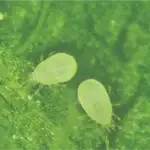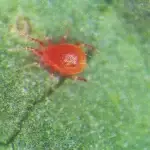Two-Spotted Mite
Overview
Two-Spotted Mite (Tetranychus urticae), also called Red Spider Mite, is a major pest in vegetable, fruit, flower and ornamental crops both indoors and outdoors all over the world.
The eggs of Two-Spotted Mites are found mostly on the underside of the leaf. They are round, have a diameter of about 0.14 mm and are transparent when laid. Under ideal conditions, a female can lay more than 100 eggs.
The colour of adult Two-Spotted Mite depends on the crop they are feeding on. Males and females usually have two large black spots on each side of the body, which can vary in size and shape. In harsh summer conditions, the female can be a bright red colour, and there can also be an orange overwintering form that can be mistaken for the red-coloured predatory mite, Phytoseiulus persimilis.
Two-Spotted Mite quickly become active during warm, hot and dry conditions. They spread to adjacent plants by moving on the ground or along crop wires. They can spin silk threads which they use to release themselves from the plant surface, and can be moved to new sites by air currents and wind. They can also be dispersed by infected plant seedlings, machinery, workers’ hands or clothing, or even birds.
Why you need to control Two-Spotted Mite
Two-Spotted Mite can damage your plants at all active life stages.
Two-Spotted Mite mostly appear on the underside of the leaves where they pierce plant cells and suck out their contents. Those cells then turn yellow, and on many plants, you will see the damage the mites cause on the upper surface of the leaf as small white-yellow spots. With increasing damage, the leaves turn completely yellow and with the photosynthetic area gone, the leaf dies and sometimes the whole plant can eventually be killed.
Two-Spotted Mite nymphs and adults also produce webs. If there are large numbers of mites present, the plant can be covered completely with webs that are swarming with mites, which can lead to permanent stunting or death of the plant.
Beneficial predators to control Two-Spotted Mite among crops
Biological Services sells a range of products to help you control Two-Spotted Mite in your commercial crop and can design a program incorporating Phytoseiulus persimilis (Persimilis), Neoseiulus californicus (Californicus) or Typhlodromus occidentalis (Occidentalis).
Detecting Two-Spotted Mite early is the key to managing this pest effectively with biological controls.
Naturally occurring beneficials such as Stethorus ladybirds and Six-Spotted Thrips are also excellent predators of Two-Spotted Mite.
Get tailored advice for your commercial crop
To speak with one of our qualified consultants about your current commercial crop challenge or to learn about the benefits of the IPM maintenance and monitoring services we provide, contact us.




















